Growing peppers is a lot of fun, but it doesn’t always work out perfectly. Some years, harvests can be significantly reduced by unforeseen pepper plant diseases or problems.
In this article, I will share some of the most common pepper plant problems, how to identify them, and how to prevent issues in the future. Some diseases are irreversible, other issues can be dealt with within a single growing season.
While this is not an exhaustive list of pepper plant diseases and problems, it covers the most common issues we are asked about by our fellow pepper growers.
In This Article
- Bacterial leaf spot
- Mosaic virus
- Blight
- Damping off disease
- Verticillium wilt
- Pests
- Blossom end rot
- Yellowing leaves
- Curling leaves
Bacterial Leaf Spot
Bacterial leaf spot is a common bacterial plant infection seen all around the world. It is most common in rainy, humid, and temperate climates. These are the environmental conditions in which the bacteria can spread most easily.
Leaf spot is a bacteria, so it can be spread by touch, through seeds, or via soil. Use cleanly soil and watering practices to avoid splashing the leaves with soil or cross contaminating.
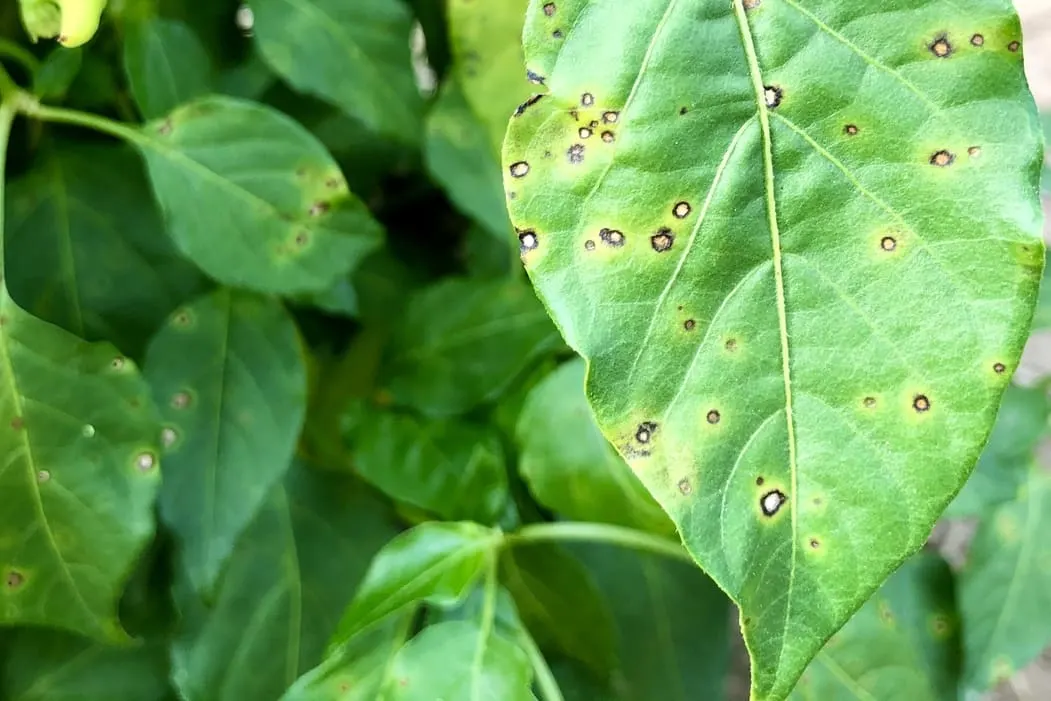
Symptoms
- Yellow and green spots on leaves
- Brown spots on leaves in later stages
- Raised, corky spots on peppers
- Leaf drop and decaying peppers
Solutions
- Remove infected parts. As with pepper plants infected with viruses, you should remove parts of the plant that show signs of leaf spot. The bacteria can spread easily, especially under damp and hot conditions. You don’t need to remove the entire plant unless it is totally covered.
- Provide adequate fertilizer. With proper nutrition, pepper plants can actually fight off the bacteria. As with humans, the more healthy we are, the more able we are to fight off bacteria quickly. Feed any affected plants with an all-purpose fertilizer at the recommended frequency. Remember, too much fertilizer is a bad thing, too, as high salts in the soil can lead to worse disease issues.
- Spray with natural fungicide. Although leaf spot is bacterial, fungal treatments have been known to help. Use a copper based fungicide as a foliar spray in the early morning or late evening to help reduce the spread.
- Avoid wetting the leaves when watering. Water is necessary for the spores to multiply and spread on your pepper plant’s leaves. Always water at the base of the plant to avoid splashing water onto the leaves.
- Practice cleanly gardening. As with all bacterial and viral pathogens, it is important to be cleanly while in the garden. If possible, use gloves when handling your plants. Avoid touching all of the plants, one after the other to reduce the spread of spores.
Learn more about various pepper leaf spot problems here.
Mosaic Virus On Peppers
Another very common pepper plant issue is mosaic virus. There are many different types of mosaic virus, and once a plant is infected, it is irreversible. Some pepper varieties are resistant to tobacco mosaic virus, while none are resistant to cucumber mosaic virus.
Mosaic viruses can be seed borne or soil borne and are spread by sap sucking insects such as aphids. They can also be spread by contact of infected plants, and are most problematic in dry weather.
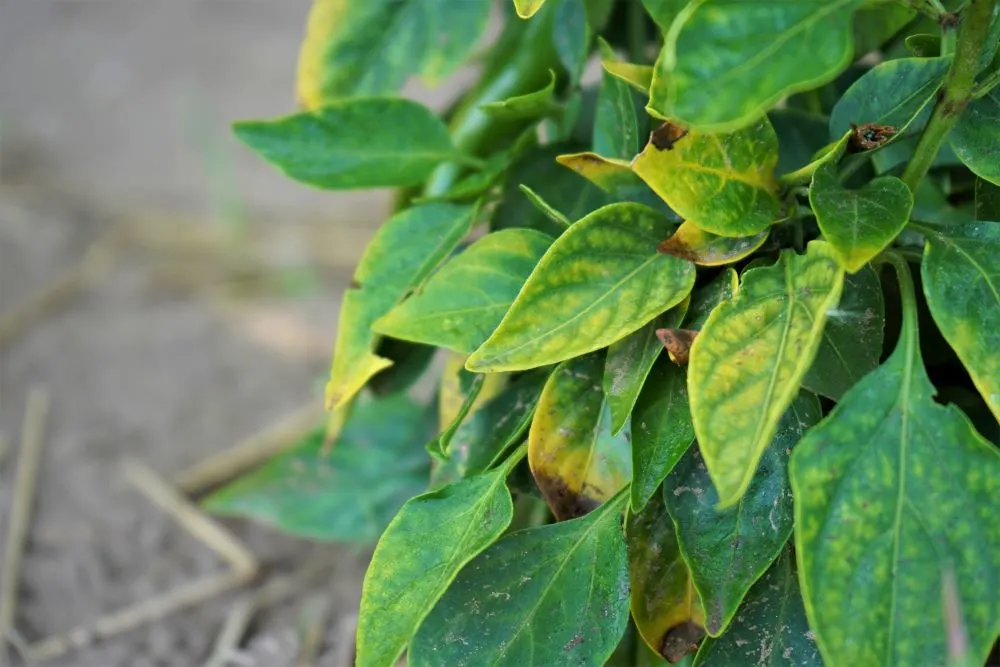
Symptoms
- Green and yellow mottled leaves
- Prickly or bumpy surface on fruits
- Stunted growth
- Low pepper production
Solutions
- Remove affected plants. There are no effective treatments for viruses. If you suspect mosaic virus, remove the pepper plants from the garden and burn them if possible. The fruits are still safe to eat, but the seeds can carry the virus, so do not save seeds from affected fruits.
- Keep the pests at bay. Mosaic viruses are commonly spread by sap sucking insects such as aphids. Use a pure neem oil solution with castile soap and water and spray plants to deal with these pests.
- Keep the weeds under control. Weeds can carry mosaic virus, and can also be a breeding ground for the insects that spread it. Use a ground cover, or at least keep the weeds at bay with a weeding hoe (these are great for saving your back).
- Avoid touching plants. Always wash your hands before and after gardening. Your hands can be the vehicle to transfer viral pathogens from one plant to another. Also, avoid smoking in your garden, as this can introduce mosaic virus to the soil.
- Plant resistant pepper varieties. Some varieties have been identified to be more resistant to tobacco mosaic virus, though none are resistant to cucumber mosaic and other viruses. Look for varieties that are labeled ‘TMV’ (tobacco mosaic virus resistant) at nurseries and garden centers. Some common types are sweet banana, super cayenne, and bell boy hybrid.
Blight On Peppers
Phytophthora blight is a pepper plant disease that is spread by a soil-borne pathogen. If your pepper plants have leaves low on the main stem, the rainfall can cause the soil to splash up on to the foliage, introducing the disease.
There are more than one type of blight, usually categorized into ‘early blight’ and ‘late blight.’ Symptoms are similar, but some are more common in different parts of the world at different times of the growing season.
There are many other plant varieties that are susceptible to blight, including tomatoes, eggplant, beans and all types of squash.
Symptoms
- Large, brown leaf spots and wilting
- Brown or black stems at base of plant
- Root rot (leading to plant death)
- Fruit rot (when in contact with infected soil)
Solutions
Plant your peppers in a raised bed or in pots to improve drainage. Blight is most commonly found in in-ground gardens or fields. Rainfall will have less time to sit on the surface of the soil and spread the pathogen in a raised bed or a potted plant.
If you can’t use a raised bed or pot, try mounding up the soil around each plant to avoid standing water at the base of the plants.
Another step to take is to use a mulch, such as straw, grass clippings, or black tarp. Mulching helps prevent splashing from the soil onto your pepper plant’s leaves when it rains. It also has other benefits like improved water retention and subduing weeds.
If it is dry, do not over-water your garden. Standing water is the only way that blight mold spores can multiply and spread. Wherever the infected water flows, the spores will follow.
Always acquire your soil and/or compost from trustworthy sources. Bringing infected soil into the garden is the easiest way to end up with this pepper plant problem.
Damping Off Disease
Damping off disease is a common cause of death in young pepper plants. It can be caused by a variety of fungi and molds. All of the pathogens thrive in moist, cool conditions (usually below 65°F).
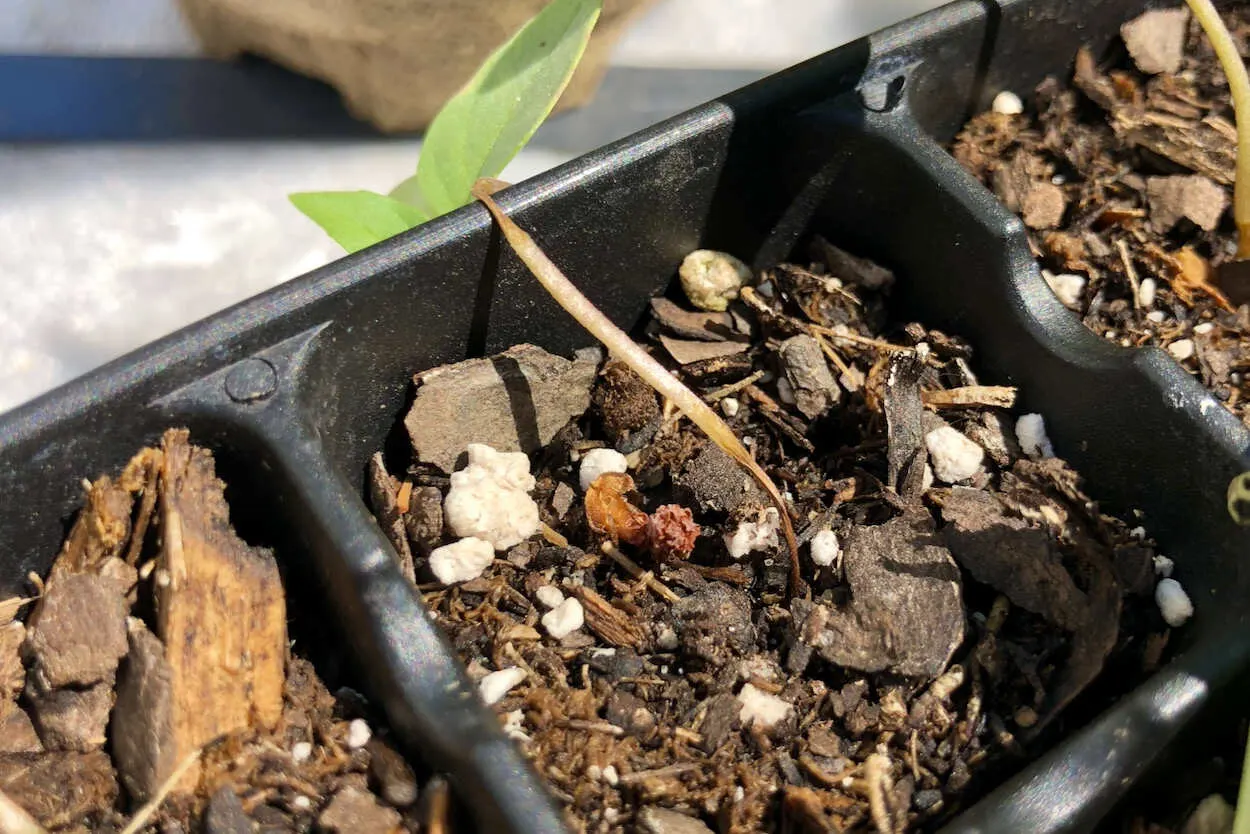
Symptoms
- Seedlings fail to sprout from soil
- Brown spots on seedling leaves
- Browning on lower stem
- Soft, slimy foliage
- Young seedlings fall over and die
Solutions
- Keep garden tools clean. Always practice good hygiene in the garden. Clean your tools at the end of the season using hot, soapy water and allow them to fully dry. Also, after working in the garden, make sure to clean your hands (I usually just take a shower) and wash clothes. Watering cans and hose nozzles that have been in contact with the soil can also harbor the spores.
- Don’t over-water. In addition to the many issues caused by over-watering, damping off is more likely in an overly-moist soil. Allow the surface of the soil to dry before adding more water to pepper seedlings.
- Keep it warm. We use a seedling heat mat to germinate our pepper seeds at around 80°F, then use grow lights after they sprout. The lights keep the grow tent warm, between 70-75°F.
Damping off is a severe issue that can spread from one seed cell tray to another, and if affects many different plant species. It is common to see entire trays of plants perish when damping off disease occurs, so take good care to prevent it.
Verticillium Wilt On Peppers
Bacterial wilt is an issue that can impact pepper plants along with many other vegetables. It is commonly found in former tobacco fields, and can wreak havoc on entire crops if not caught early. It is most common in the Southeastern US.
The bacteria plugs up the vascular tissue of the plant, making it impossible for water to be transferred throughout the plant. Typically, pepper plants infected with verticillium wilt will begin to wilt on one side of the plant first.
As the bacteria grows, the plant will eventually collapse and die. If it is discovered, this pepper plant problem should be dealt with immediately.
Symptoms
- Yellowing and wilting leaves, sometimes starting on one side of the plant
- Vascular discoloration (inner tissues of the stems turning brown)
- Fully collapsed plants (death)
Solutions
- Water your plants. The most common reason for pepper plants wilting is simply a need for water. Don’t over-react to wilting, assume it is bacterial wilt, and rip up your plants! Try some water first, and if that doesn’t solve the issue in an hour or so, investigate further. Learn more about pepper plants wilting here.
- Remove affected plants. As with most diseased plants, the first step is to remove and destroy affected plants. Only resort to this step if you are sure that your plants are infected.
- Control pests. Cucumber beetles and other insects can spread bacteria from one plant to another. Learn how to identify and control these pests and others to keep bacterial wilt from spreading and persisting in your pepper garden.
- Add beneficial bacteria to soil. Using beneficial bacteria has been shown to be effective at treating bacterial wilt. This method may be better suited for professional farmers who grow peppers and other veggies for profit.
Pests On Pepper Plants
Pests can cause significant damage to pepper plants on their own. From aphids to spider mites to thrips, the list of potential pepper plant pests is long. Thankfully, there are preventative measures you can take against most of them.
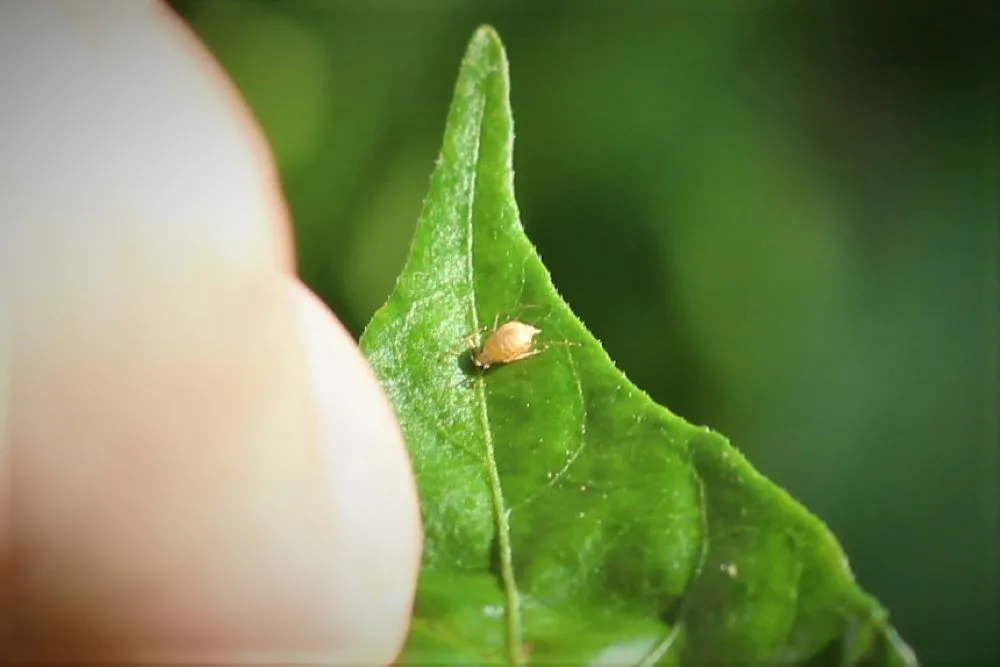
Symptoms
- Visible pests (check under leaves, on stems, etc.)
- Leaf curling or distortion
- Dark spots on leaves
- Holes in leaves
Solutions
The type of pest will often determine the best solution. Sometimes, you can simply remove the pests, as with caterpillars, slugs, and earwigs. However, others are small and come in large numbers to feast on your pepper plants.
- Spray with a hose. Aphids and other small, sap sucking insects can’t fly, and do not have a very strong grip. By spraying the leaves directly with clean water, you can knock a majority of these pests off of the plant. This isn’t a permanent solution, but it can slow them down.
- Spray with neem oil. Spray your pepper plants using a solution of 1 tbsp pure neem oil, 1 tbsp castile soap, and 6 cups of water. The neem oil is all-natural and will kill active pests and deter new ones from joining the party.
- Introduce beneficial insects. Lady bugs and predatory wasps are some of the most common beneficial garden bugs. You can attract them by planting certain companion plants, or buying larvae to hatch in your garden. Always release live ladybugs in the evening when the sun is going down to avoid them flying away. The ladybugs will stay and feast on aphids and other sap suckers.
The list of pepper plant pests is lengthy, and this is in no way a complete guide to controlling them. However, a general rule is to grow a diverse range of plants so that natural predatory insects come to control the pest populations. For more info on dealing with aphids, read here.
Blossom End Rot On Peppers
Blossom end rot is most common on tomatoes and large sweet pepper varieties. It is primarily caused by a lack of calcium within the plant which leads to an inability to form the fruit’s skin. It is not actual rot, but just an underdeveloped fruit.
The pepper skin will develop dark, soft spots, usually on the bottom of the fruits. This vulnerable skin invites mold to grow, making the affected part of the fruit inedible.
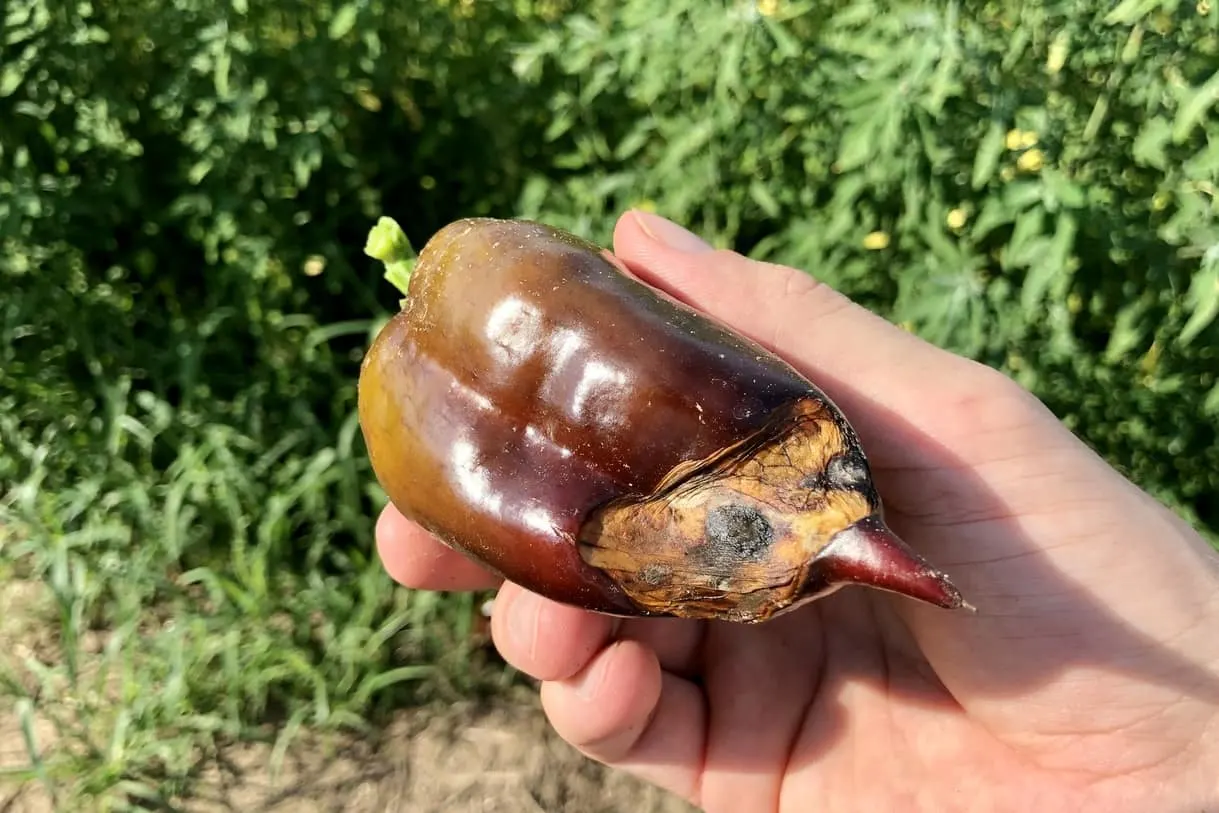
Symptoms
- Soft spots on bottom of pepper pods
- Shriveled and dead skin
- Mold inside of peppers
Solutions
- Water evenly. Even though the issue is calcium-related, providing calcium rarely fixes the issue. Most of the time, BER is caused by improper watering; allowing the plant to become completely dehydrated, then flooding it with lots of water. This causes the plant to transpire much of the absorbed water through the leaves, and for most of the available calcium to bypass any developing fruits. Instead, water before your pepper plants start to wilt from lack of water, keeping soil evenly moist and well-drained.
- Wait it out. It is fairly common for the earliest fruits to have blossom end rot, while later fruits will be normal. Sometimes, the best thing to do is to simply do nothing at all and wait for your plants to sort things out themselves!
In case you are not already, be sure to fertilize regularly with a solution containing calcium.
Learn more about blossom end rot on peppers here.
Yellowing Leaves
One of the most common issues pepper growers face is the dreaded yellowing leaves. While it is usually not a big deal, there are measures you need to take to correct this pepper plant problem.
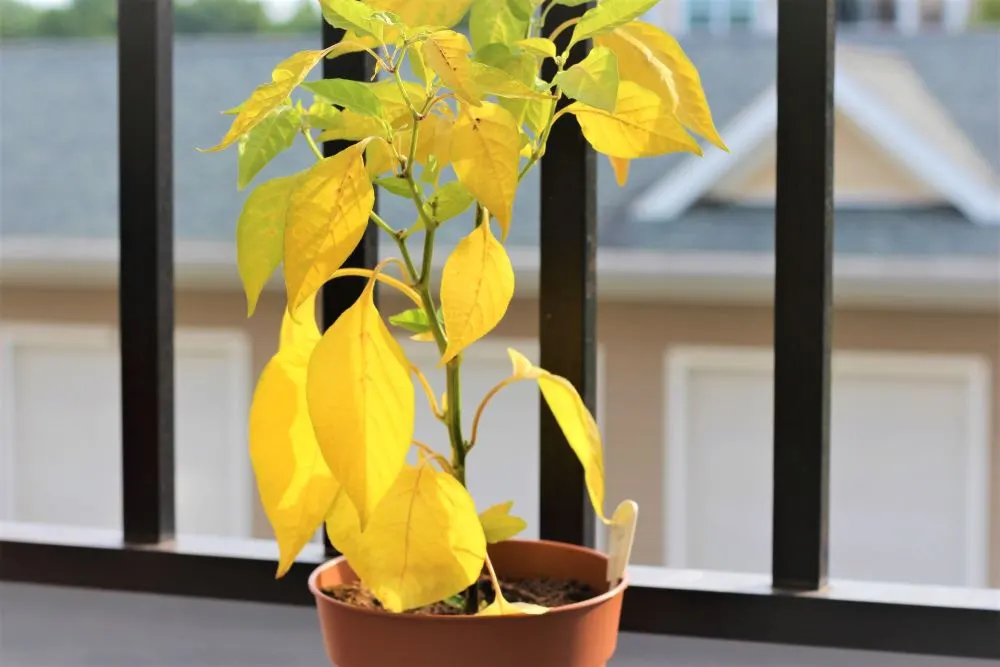
Symptoms
- Yellowing leaves
- Leaf veins turning yellow
- Leaves falling off
Solutions
While the solutions to yellowing leaves will vary depending on the cause, here are a few potential fixes.
- Provide nitrogen. Nitrogen is an essential nutrient for healthy plant development. It helps pepper plants grow lots of big, strong green leaves. It is also the most common nutrient to be deficient in soil. Make sure you are fertilizing regularly and that your fertilizer contains enough nitrogen. Also, get a soil test annually if you are planting in the ground.
Tip: If the problem is nitrogen, the yellowing leaves will begin at the bottom of the plant, moving upwards over time.
- Provide magnesium & calcium. A magnesium deficiency will cause chlorosis when severe, meaning the veins of leaves will remain green while the rest turns yellow. Use a cal-mag spray or use soil amendments like bone meal and blood meal when planting peppers. Many all-purpose fertilizers contain these secondary nutrients.
- Don’t over-water. Over-watering is another possible reason for pepper plants turning yellow. Be sure to only provide water when necessary and to allow potted plants to drain excess water. Peppers prefer even-moisture, so use a moisture meter or allow the first inch or two of soil to dry between waterings.
Learn more about pepper plants turning yellow here.
Curling Leaves
Here is a problem faced by first-time and veteran pepper growers alike. With so many possible causes, treating curled pepper leaves can be tricky.
Most of the time, curling pepper leaves is a sign of either too much light, too much water, or plant edema. There are diseases that can cause curled leaves, but if the plant appears otherwise healthy, it is most likely one of these causes.
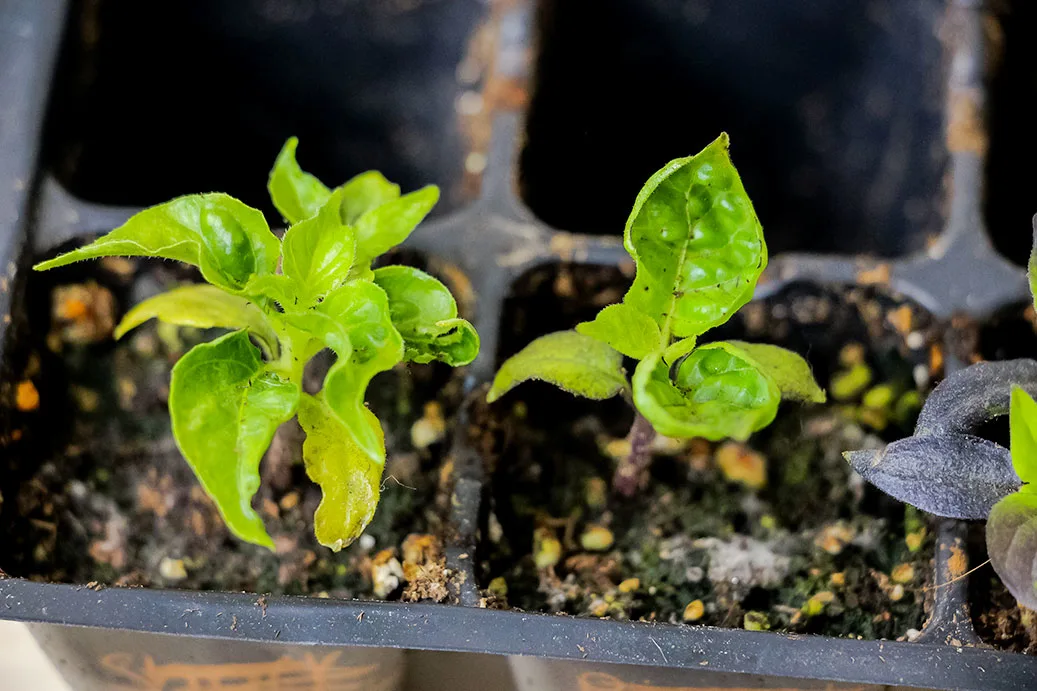
Symptoms
- Curling leaves
- Distorted leaves
- Stunted growth
Solutions
- Move grow lights up. If you are growing peppers from seed indoors, your grow light may be too close to your plants. If you are using an LED light, it should probably be at least 12-15 inches from the plant leaves, depending on the light’s power. Read up on your specific light unit and be sure that your plants have enough space.
- Increase airflow. Plant edema is caused by environmental conditions, especially poor air circulation and over-watering. If your plants appear to have white crystallized bumps along the underside of leaves, they may have edema. Increase airflow with a fan if indoors, or by spacing peppers farther apart outdoors.
- Make sure your soil has calcium. Pepper plants require calcium in order to properly form strong cell walls. This is what gives the leaves and pepper pods their symmetrical, uniform shape. When calcium is deficient or missing, the leaves and fruits may distort. Ground soil is rarely deficient in calcium, but potted plants can be affected. Check your potting soil’s ingredients. If calcium is not mentioned, be sure to provide calcium with an all-purpose fertilizer like this one.
- Don’t over-water. We’ll say it again, over-watering is bad! Don’t provide too much water for your pepper plants. It can cause curling leaves, too.
I hope this article helped you diagnose your pepper plant problems. While these are by no means the only issues you may have with your pepper plants, they are definitely the most common problems we have seen.
Keep a close eye on your plants, look out for any changes, and most importantly, keep them healthy and happy with enough nutrients, water and sunlight! Happy pepper gardening.

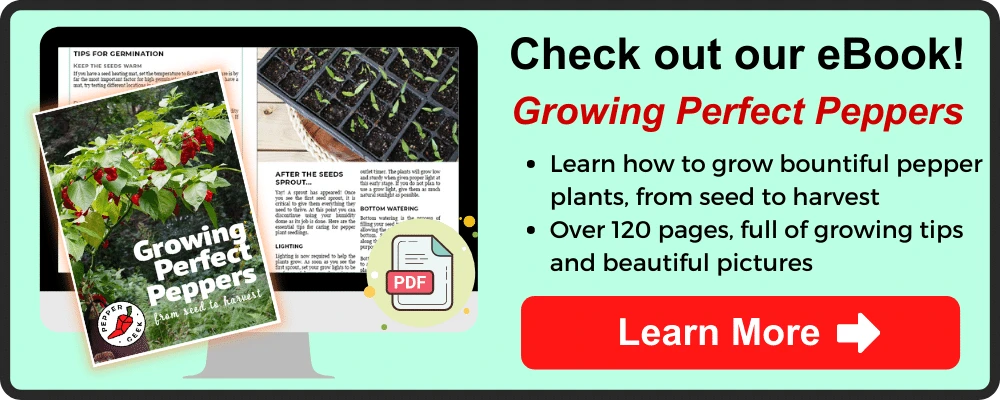


Francis
Tuesday 12th of March 2024
Hi pepper geek thanks for the article Planted pepper, it has started flowering but the stamen doesn't open that is it doesn't release any pollen it just remains the same way then the flower falls off after some time pls what could be the problem
peppergeek
Wednesday 20th of March 2024
It could be heat or another form of stress. In rare cases, a plant can be sterile (infertile), but usually only if the seed is a hybrid (usually accidental)
Che
Friday 26th of January 2024
Hello. I've been watching your youtube videos in preparation for spring. I have a question about jalapenos. One year we planted them from seed and the heat level was just as expected, but the next year, same package of seeds, but heat level was off the charts. We made jalapeno pickles, but they were too hot for us. We did remove the seeds and white membranes. Our spice-loving son-in-law thought it was too hot too, but suggested his friend, who went through chemo and could hardly taste anything would like them. They were too hot even for him. How does that happen?
peppergeek
Monday 29th of January 2024
Funny you bring this up now, we recently released an article on growing hotter peppers, along with a video that covers how capsaicin levels change in plants based on their environment and genetics. Hope this is helpful!
Lex
Thursday 18th of January 2024
Hello, I am in South Texas and we had 3 days of teen temps. I had my pepper plants in a green house, and they still got damaged all the leaves are soggy and brown when i pulled them out some plants had all white roots, some had dead roots, some had a mix. What should I do?
peppergeek
Friday 19th of January 2024
That's rough! Especially on potted peppers that don't have any insulation for the roots. Many varieties of peppers will die from that sort of incident. I'd say assess the damage and try to avoid it next time by moving potted plants to a warmer location. For in ground plants, insulate with mulch or cover with plastic.
Paul Mvula
Wednesday 17th of January 2024
Now that it is raining heavily and it is getting colder and colder, is it the right time to grow green pepper and how often can you be applying chemicals in order to have healthy production. When harvesting, what are the good sizes that can determine your harvest?
Ricky Kent
Wednesday 3rd of January 2024
Hi Calvin, I have quite a few pepper seedlings where the plant looks healthy but the branches are growing sideways or downward. Any thoughts? I am using growlights.
peppergeek
Monday 8th of January 2024
If the main stem is bending, it could be from low light (leggy growth), or it could just need a bit of time to stiffen up that main stem. You can use wood skewers to support the plants temporarily while they're young, until the main stems develop of bit of bark/strength